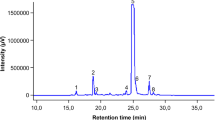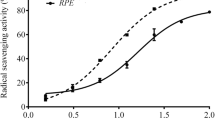Abstract
Cadmium (Cd) is an environmental pollutant and has been found to pose a potential threat to human health. Isoquercitrin (IQ) is one of the most important flavonoids and has been demonstrated to exhibit potent antioxidant effects on plants and yeast cells. However, only few studies have investigated the antioxidative activities of reactive oxygen species (ROS) and the nitrite scavenging activities of IQ against Cd-induced oxidation in mouse. The present work was to investigate the ROS and nitrite-scavenging activities of IQ in vitro as well as its preventive effects against lipid peroxidation and protein oxidative damage in liver and kidney of mouse induced by Cd2+ using spectrophotometry. Our results showed that IQ possesses scavenging abilities for superoxide anion, hydroxyl radical and nitrite. Such scavenging capacities increase with the concentration of IQ. Moreover, cadmium chloride (CdCl2) (2.5 mg/kg body weight, i.p. CdCl2) significantly inhibited the activities of superoxide dismutase and catalase and raised the levels of malondialdehyde, nitric oxide, protein carbonyl, and the coefficients of DNA-protein crosslinks in livers and/or kidneys of mice. IQ attenuated the Cd2+-induced biochemical alterations in the livers and/or kidneys of mice, indicating that the formation of ROS and nitrite is possibly reduced. Our work demonstrates that IQ possesses ROS and nitrite-scavenging capacities and plays a significant role in combating Cd2+-induced toxicity in animals.





Similar content being viewed by others
References
Bradford MM (1976) A rapid and sensitive method for the quantitation of microgram quantities of protein utilizing the principle of protein-dye binding. Anal Biochem 72:248–254
Butterweck V, Jurgenliemk G, Nahrstedt A, Winterhoff H (2000) Flavonoids from Hypericum perforatum show antidepressant activity in the forced swimming test. Planta Med 66:3–6
Cai Y, Luo Q, Sun M, Corke H (2004) Antioxidant activity and phenolic compounds of 112 traditional Chinese medicinal plants associated with anticancer. Life Sci 74:2157–2184
Caldenitritee V, Chericoni S, Martinelli C, Testai L, Nardi A, Morelli I, Breschi MC, Martinotti E (2004) Vasorelaxing effects of flavonoids: investigation on the possible involvement of potassium channels. Naunyn-Schmiedeberg’s Arch Pharmacol 370:290–298
Casalino E, Sblano C, Landriscina C (1997) Enzyme activity alteration by cadmium administration to rats: the possibility of iron involvement in lipid peroxidation. Arch Biochem Biophys 346:171–179
Chen M, Xie JM, Jin JJ (2003) Comparative effects of chelating agents on lipid peroxidation in mice organs by acute exposure to cadmium. J Environ Occup Med 20:222–224
Corticeiro SC, Lima AIG, de Almeida Paula Figueira EM (2006) The importance of glutathione in oxidative status of Rhizobium leguminosarum biovar viciae under Cd exposure. Enzyme Microb Technol 40:132–137
Costa M (1991) Molecular mechanisms of nickel carcinogenesis. Annu Res Pharmacol Toxicol 31:321–337
de Flora S, Wetterhahn KE (1989) Mechanisms of chromium metabolism and genetoxicity. Life Chem Res 7:169–244
Dmitriev LF, Titov VN (2010) Lipid peroxidation in relation to ageing and the role of endogenous aldehydes in diabetes and other age-related diseases. Ageing Res Rev 9:200–210
Fiorentino A, Abrosca BD, Pacifico S, Golino A, Mastellone C, Oriano P, Monaco P (2007) Reactive oxygen species scavenging activity of flavone glycosides from Melilotus neapolitana. Molecules 12:263–270
Grassi D, Desideri G, Croce G, Tiberti S, Aggio A, Ferri C (2009) Flavonoids, vascular function and cardiovascular protection. Curr Pharm Des 15:1072–1084
Hassoun EA, Stohs SJ (1996) Cadmium-induced production of superoxide anion and nitric oxide, DNA single strand breaks and lactate dehydrogenase leakage in J774A.1 cell cultures. Toxicology 112:219–226
Herrmann K (1988) On the occurrence of flavonol and flavone glycosides in vegetables. Z Lebensm Unters Forsch 186:1–5
Inaba H, Tagashira M, Honma D, Kanda T, Kou Y, Ohtake Y, Amano A (2008) Identification of hop polyphenolic components which inhibit prostaglandin E2 production by gingival epithelial cells stimulated with periodontal pathogen. Biol Pharm Bull 31:527–530
Job P (1928) Formation and stability of inorganic complexes in solution. Ann Chim 9:113–203
Joseph P (2009) Mechanisms of cadmium carcinogenesis. Toxicol Appl Pharmacol 238:272–279
Julie MF, Bogdan GS, Istvan S (1999) Quantitation of oxidative damage to tissue proteins. Int J Biochem Cell Biol 31:751–757
Jung SH, Kim BJ, Lee EH, Osborne NN (2010) Isoquercitrin is the most effective antioxidant in the plant Thuja orientalis and able to counteract oxidative-induced damage to a transformed cell line (RGC-5 cells). Neurochem Int 57:713–721
Jurczuk M, Brzoska MM, Moniuszko-Jakoniuk J, Galazyn-Sidorczuk M, Kulikowska-Karpinska E (2004) Antioxidant enzymes activity and lipid peroxidation in liver and kidney of rats exposed to cadmium and ethanol. Food Chem Toxicol 42:429–438
Kumar A, Malik AK, Tewary DK (2009) A new method for determination of myricetin and quercetin using solid phase microextraction-high performance liquid chromatography-ultraviolet/visible system in grapes, vegetables and red wine samples. Anal Chim Acta 631:177–181
Lei BP, Zhou PT, Cai HW, Yin CN, Tan XJ, Xu QM (1993) Colorimetry for catalase activity determination. Chin J Clin Lab Sci 11:73–75
Lin LZ, He XG, Lindenmaier M, Nolan G, Yang J, Cleary M, Qiu SX, Cordell GA (2000) Liquid chromatography-electrospray ionization mass spectrometry study of the flavonoids of the roots of Astragalus mongholicus and A. membranaceus. J Chromatogr A 876:87–95
Liu J, Qu W, Kadiiska MB (2009) Role of oxidative stress in cadmium toxicity and carcinogenesis. Toxicol Appl Pharmacol 238:209–214
Liu H-M, Zheng Y-L, Lu J, Zhang Z-F, Fan S-H, Wu D-M, Ma J-Q (2010) Quercetin protects rat liver against lead-induced oxidative stress and apoptosis. Environ Toxicol Pharm 29:158–166
Mak IT, Zhang J, Weglicki WB (2002) Protective effects of dihydropyridine Ca-blockers against endothelial cell oxidative injury due to combined nitric oxide and superoxide. Pharmacol Res 45:27–33
Meneghini R (1997) Initrite hemeostasis, oxidative stress and DNA damage. Free Radical Biol Med 23:783–792
Middleton E, Chithan K, Theoharides TC (2000) The effects of plant flavonoids on mammalian cells: implications for inflammation, heart disease, and cancer. Pharmacol Rev 52:673–751
Nigam D, Shukla GS, Agarwal AK (1999) Glutathione depletion and oxidative damage in mitochondria following exposure to cadmium in rat liver and kidney. Toxicol Lett 106:151–157
Olthof MR, Hollman PCH, Vree TB, Katan MB (2000) Bioavailabilities of quercetin-3-glucoside and quercetin-4-glucoside do not differ in humans. J Nutr 130:1200–1203
Packer MA, Porteous CM, Murphy MP (1996) Superoxide production by mitochondria in the presence of nitric oxide from peroxynitrite. Biochem Mol Biol Int 40:527–534
Razavi SM, Zahri S, Zarrini G, Nazemiyeh H, Mohammadi S (2009) Biological activity of quercetin-3-O-glucoside, a known plant flavonoid. Bioorg Khim 35:414–416
Rice-Evans CA, Miller NJ, Paganga G (1996) Structure-antioxidant activity relationships of flavonoids and phenolic acids. Free Radical Biol Med 20:933–956
Rogerio AP, Kanashiro A, Fontanari C, da Silva EVG, Lucisano-Valim YM, Soares EG, Faccioli LH (2007) Anti-inflammatory activity of quercetin and isoquercitrin in experimental murine allergic asthma. Inflamm Res 56:402–408
Satarug S, Baker JR, Urbenjapol S, Haswell-Elkins M, Reilly PEB, Williams DJ, Moore MR (2003) A global presepective on cadmium pollution and toxicity in nonoccupationally exposed population. Toxicol Lett 137:65–83
Shore RF, Douben PE (1994) The ecotoxicological significance of cadmium intake and residues in terrestrial small mammals. Ecotox Environ Saf 29:101–112
Silva CG, Raulino RJ, Cerqueira DM, Mannarino SC, Pereira MD, Panek AD, Silva JFM, Menezes FS, Eleutherio ECA (2009) In vitro and in vivo determination of antioxidant activity and mode of action of isoquercitrin and Hyptis fasciculate. Phytomed 16:761–767
Snyder S, Bredt HDS (1992) Biological roles of nitric oxide. Sci Am 266:68–7l
Stoch SJ, Bagchi D (1995) Oxidative mechanism in the toxicity of metal ions. Free Radical Biol Med 18:321–336
Strauss L, Santti R, Saarinen N, Streng T, Joshi S, Makela S (1998) Dietary phytoestrogens and their role in hormonally dependent disease. Toxicol Lett 102–103:349–354
Valko M, Leibfritz D, Moncola J, Cnitritein MTD, Mazura M, Telser J (2007) Free radicals and antioxidants in normal physiological functions and human disease. Int J Biochem Cell Biol 39:44–84
Wang YD, Fang J, Leonard SS, Rao KMK (2004) Cadmium inhibits the electron transfer chain and induces reactive oxygen species. Free Radical Biol Med 36:1434–1443
Wasoxicz W, Neve J, Pevetz A (1993) Optimized steps in fluorometric determination of thiobarbituric acid-reactive substance in serum: importance of extraction pH and influence of sample preservation and storage. Clin Chem 39:2522–2526
Whitaker SJ (1992) DNA damage by drugs and radiation: what is important and how is it measured? Eur J Cancer 28:273–276
Xie J, Fan R, Meng Z (2007) Protein oxidation and DNA-protein crosslink induced by sulfur dioxide in lungs, livers, and hearts from mice. Inhal Toxicol 19:759–765
Xu YJ, Zhao YJ, Hu H (2006) Research on the measurement of the SOD activity via pyrogallol auto-oxidation. Chin J Southwest Univ 6(1207–1209):1212
Yokohira M, Yamakawa K, Saoo K, MatsudaY HK, Hashimoto N, Kuno T, Imaida K (2008) Antioxidant effects of flavonoids used as food additives (purple corn color, enzymatically modified isoquercitrin, and isoquercitrin) on liver carcinogenesis in a rat medium-term bioassay. J Food Sci 73:C561–568
Yokozawa T, Dong E, Kawai Y, Gemba M, Shimizu M (1999) Protective effects of some flavonoids on the renal cellular membrane. Exp Toxicol Pathol 51:9–14
Yu QG, Liu JP, Wu MQ (2008) The experimental improvement of Chinese herbs scavenging hydroxyl radical. Chin J Lishizhen Med Materia Medica Res 19:1107–1108
Yu ZF, Fu YJ, Wang M, Wang J, Zheng H (2007) Study on free radical scavenging capacity by tartary buckwheat total flavonoids extract. Chin J Food Sci Technol 32:126–129
Zheng H, Yan PP, Cai WX, Huang WM, Ye QL (1997) Method for measurement of nitrite in serum. Chin J Fujian Med Univ 31:452–454
Zielinska D, Wiczkowski W, Piskula MK (2008) Determination of the relative contribution of quercetin and its glucosides to the antioxidant capacity of onion by cyclic voltammetry and spectrophotometric methods. J Agric Food Chem 56:3524–3531
Acknowledgments
This work was supported by the Major Research Plan of the National Natural Science Foundation of China (90813018), China Postdoctoral Science Foundation Funded Project (20100471580), and Nature Science Foundation of Shanxi Province, China (2009011039-1).
Author information
Authors and Affiliations
Corresponding authors
Rights and permissions
About this article
Cite this article
Li, R., Yuan, C., Dong, C. et al. In vivo antioxidative effect of isoquercitrin on cadmium-induced oxidative damage to mouse liver and kidney. Naunyn-Schmiedeberg's Arch Pharmacol 383, 437–445 (2011). https://doi.org/10.1007/s00210-011-0613-2
Received:
Accepted:
Published:
Issue Date:
DOI: https://doi.org/10.1007/s00210-011-0613-2




